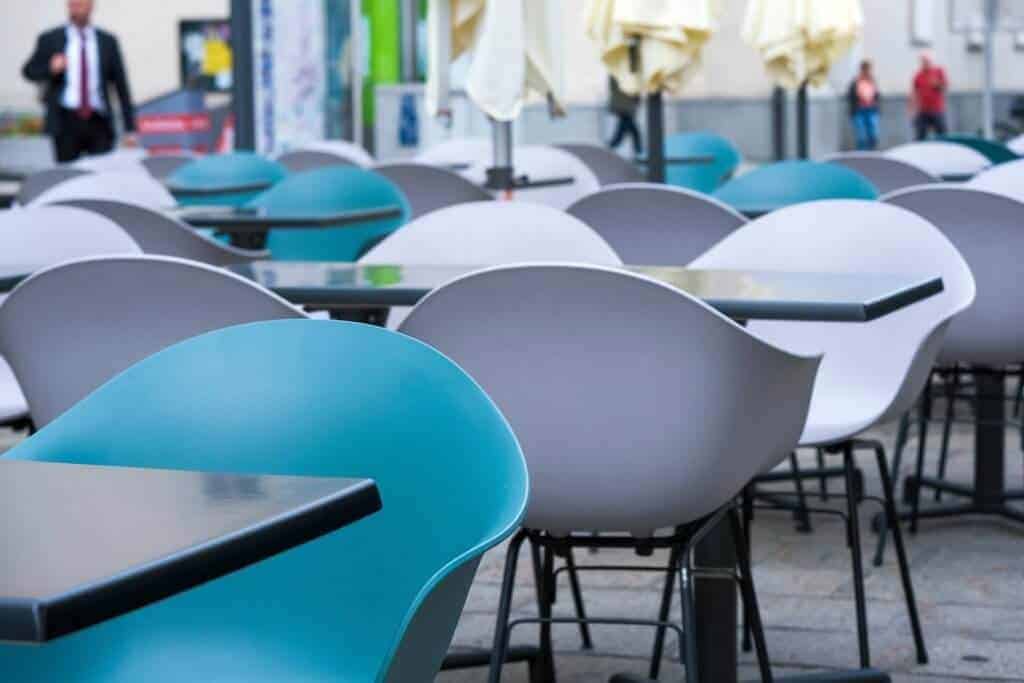
This guest post on COVID-19 and Physical Education has been written by Will Swaithes who has over 20 years’ experience within PE. Will is an education consultant and specialist leader in education, and recently completed his Masters in Educational Leadership with a dissertation on the relationship between happiness and daily physical activity and has engaged with over 100 schools throughout this time of uncertainty to support their response to ‘life with Covid’, as well as contributing to numerous webinars that attracted upwards of 3,000 practitioners globally. Here he shares his thoughts, insight, and reflections.
Feeling the immediate effects
2020 has been a rollercoaster of a year and is not over yet. When schools in the UK went into lockdown, it felt like Joe Wicks was the only person with the reach, energy and tenacity to respond quickly enough to offer something in terms of daily physical activity support for children. Well intentioned but also recognised by many within the profession as falling far short of meaningful and personalised physical education, this clearly could only serve as a stop gap. However, almost all physical educators across the country and arguably across the globe were faced with substantial challenges:
- Entering the unknown – with no model or plan for what could or should replace timetabled face to face PE
- Home working – remembering that in fact, we weren’t working from home but perhaps more accurately living at work through a crisis whilst trying to juggle family life
- Digital illiteracy – schools had been trying for years to encourage and embed more meaningful online learning and connectivity with home. Suddenly this became more than a priority, it was a necessity, and many just were not geared up to offer it
- Awful timing – not as though there’s ever a ‘good time’ for a global pandemic but the rapidly changing and very unfamiliar situation occurred at a critical moment for examination groups (especially Year 11 and 13 who were about to hit the most important months of their schooling in terms of securing results). These cohorts remained a central focus due to the significance of Progress-8 performance on school accountability as well as unlocking the next stage of life for students
- Reactive and devolved leadership – the government and Ofqual were equally ill prepared for the unprecedented turn of events and consequently everyone appeared in a reactive state trying to mitigate damage whilst DfE and Ofqual repeatedly planned, replanned and U-turned their response in an attempt to find a fair and robust solution to an education system that has become so focused on exams.
- The Wicks Effect – The Body Coach had wanted to do more with schools for a number of years so Wicks quickly crowned himself the nations PE teacher, which certainly filled a void for many young people. Meanwhile, many custodians of PE and researchers in the field were very quick to say that ‘PE with Joe’ wasn’t PE at all, but most struggled to reconsider how and what they could deliver that offered more
- The disadvantage gap – in one foul swoop Covid-19 threatened years of hard work seeking to improve social mobility and reduce inequality in education but the differences in access to digital devices to get online, physical spaces for meaningful movement inside or out, and adult support for learning were beyond significant
Time to reflect and reframe what matters most in Physical Education
I have been lucky enough to see and support some amazing provision for PE across the country. There are some incredible practitioners leading the way but I believe we are only as good as our weakest link and unfortunately that isn’t nearly good enough. However, as Benjamin Franklin wisely once said, “out of adversity comes opportunity” and, perhaps, this turn of events could provide the moment for practitioners to step back from relentless operational delivery to consider if all that they were doing ‘before’ was actually M.A.D? And by that, I mean, what was actually ‘Making A Difference’? To steal from the mouth of Simon Sinek, to start (back) with why? Consequently, I found myself engaging in and leading some of the most influential professional development I have for years, with a level of collaboration and appetite for change that I have not seen before.
Ofsted was put on hold; suggestions were made to scrap exams for good; and the impact of daily physical activity on wellbeing (and hence human flourishing) was recognised at the highest level – with Boris Johnson and the NHS endorsing daily bouts of outdoor exercise despite lockdown. If ever there was a time to transform Physical Education to deliver more than a ‘basket of sports’, to cater for the needs, attitudes and motivations of different individuals and to break free of its resistance to change then surely it was now?
My first step was to consider with practitioners and even school leaders if we were on the same page?
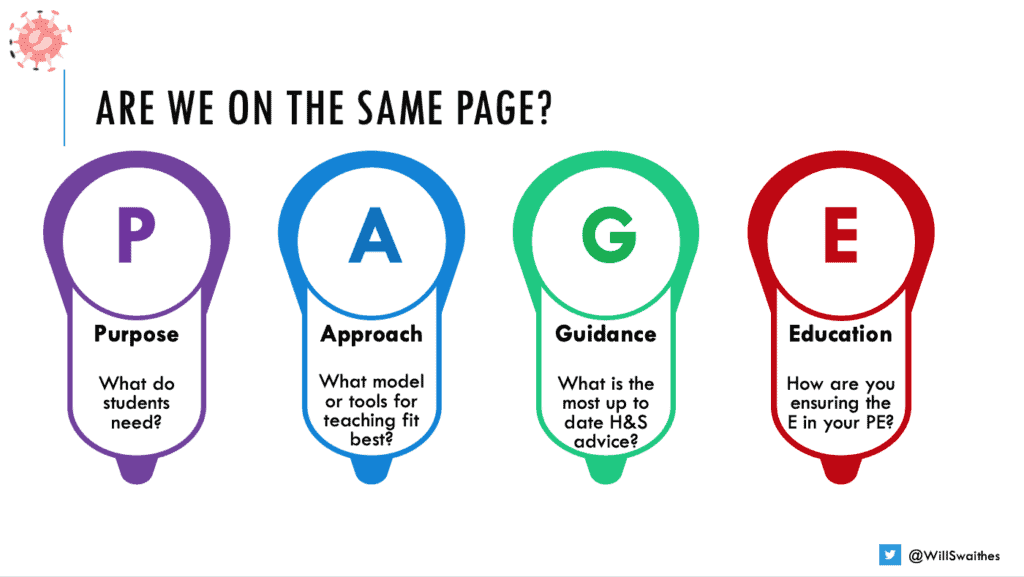
Did we have the same perception of what PE stood for and the further change necessary to ensure it is ft for 2020 and beyond?
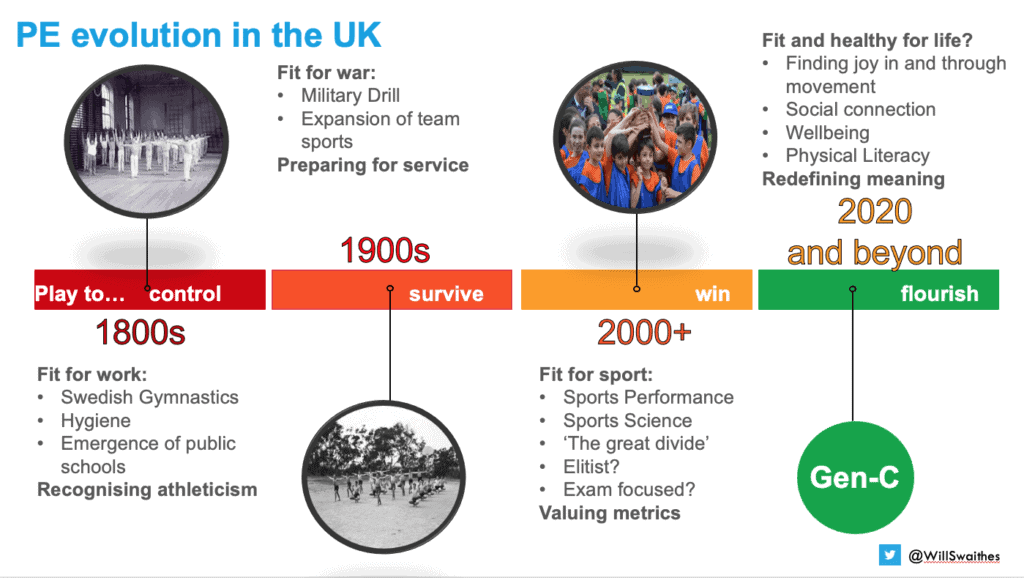
And finally, did we hold the same ‘non-negotiables’ for what every PE lesson (synchronous, asynchronous, remote or in person) should offer? e.g. Inclusive, Accessible, Meaningful, Physical & Educative (I.A.M.P.E).
This led to rich conversation and by drawing on 4 key documents[1], I was able to support leaders of PE to reconsider their ‘why’ before turning their attention to ‘how’ and ‘what’ they would offer in PE going forwards – regardless of social distancing restrictions as if I have learnt anything about the PE profession they are certainly creative and committed to get things done! Too many of us have spent too much time wrapped up in prioritising PE examination groups, consisting of less than 25% of students[2] and servicing the needs of the 10% sport enthusiasts[3] (most of whom access training and competition in their chosen sports beyond school anyway) so maybe the time has come to turn our attention to those who need us most? Most of us are committed to a child centred approach, but logistics and old habits arguably result in far too much direct instruction focused on technical development in an activity led curriculum[4] (6 week blocks of sports) that don’t always contribute to the holistic health and wellbeing or physical literacy journey that form the foundation of our curriculum intent.
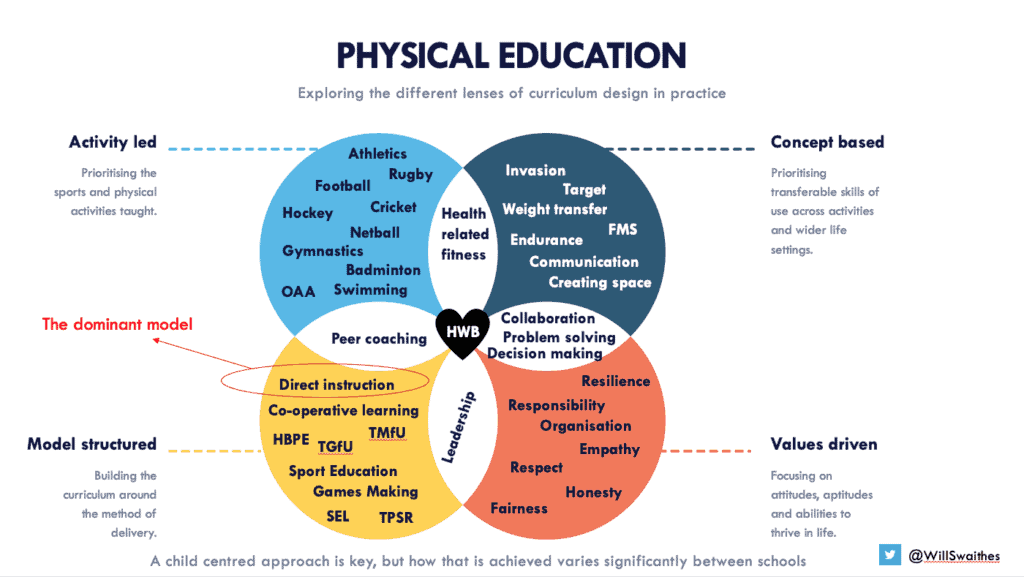
Towards the end of lockdown, I saw more schools offering more meaningful and exciting materials and lessons for home learning to include some great virtual sports days and physical challenges that went viral. However, indoor fitness-based activities still dominated[5], with suggestions that only ¼ of children were engaged in those activities[6]. The one thing I feel we perhaps didn’t see enough of, before the end of the summer term in England, was that personal interaction between teacher and student or student to student synchronously online[7]. Barriers of connection, confidence with technology and safeguarding seemed to be preventing what was already proving to be successful in many international schools[8]. Many teachers were keen to collaborate and learn but it was also becoming clear that they were running on empty. If workload was already the biggest problem driving people out of the teaching profession, the ‘summer holiday break’ could not have come soon enough, especially as many teachers had been fire-fighting family commitments, key worker provision, remote learning packs, priority year group (6, 10 & 12) return to school (most without any core PE[9]), endless contingency planning and the emotional strain of it all without a break since February half-term.
Responding to reopen
The biggest concerns for PE return post-lockdown seemed to be around:
- health and safety (to include interpretation of continually changing guidelines from DfE, afPE and NGB return to play roadmaps)[10]
- recouping lost time for examination classes with very little change to course requirements for Summer entry 2021[11]
- changing room use versus wearing PE kit on PE days[12]
- extra-curricular clubs and fixtures, with most schools opting to avoid until at least October half term[13]
With the exam’s fiasco a seemingly distant memory already by the time students stepped into classrooms in September, they were faced with a whole new world. Social distancing plans consisting of bubbles, staggered school days, ‘recovery curriculums’ and more risk assessments than you could shake a stick at prepared schools for the safest restart possible. But, practical subjects like technology, science, performing arts and PE had additional challenges to overcome. Despite pressure to the contrary, including words from Amanda Spielman seemingly intent on kickstarting Ofsted inspections again, a worrying 21% of schools have chosen to reduce PE time[14]. Many schools opted for a ‘random activities’[15] approach to the start of term, with others adopting typically summer term activities like athletics to simplify social distancing and reduce equipment use and hence cleaning. As I write this, schools are now considering how they can cope with a potentially wet winter and integrate more traditional games back into their offer whilst also preparing for the high likelihood of a tier 2 lockdown or more as the R value continues to spike again. Instances of needing to plan for multiple contingencies for many lessons make workload unbearable once more. One example is of a colleague needing to plan four separate lessons for one timetabled slot to cover all eventualities – outdoor PE lesson as planned; wet weather classroom alternative required as changing rooms not feasible for cohort sizes; live remote teaching in the instance of bubble self-isolation; and teaching majority of class whilst providing home learning for an individual who is self-isolating. This situation is obviously not sustainable.
I have encouraged leaders to focus in on their context; to pay even closer attention to the needs of their individual cohorts; and to diagnostically assess then prioritise the wellbeing and learning gaps that are most prominent. Of these, the biggest priorities to me feel like safety, happiness, wellness (physical, emotional and social), confidence moving and independence to seek physical activity beyond the school gates. In other words, for the time being placing a greater emphasis on Maslow’s hierarchy of needs than Bloom and his higher order thinking skills. The potential model which I have created to reflect this, for the autumn term at least, is this ‘Physical Education Recovery Curriculum’.
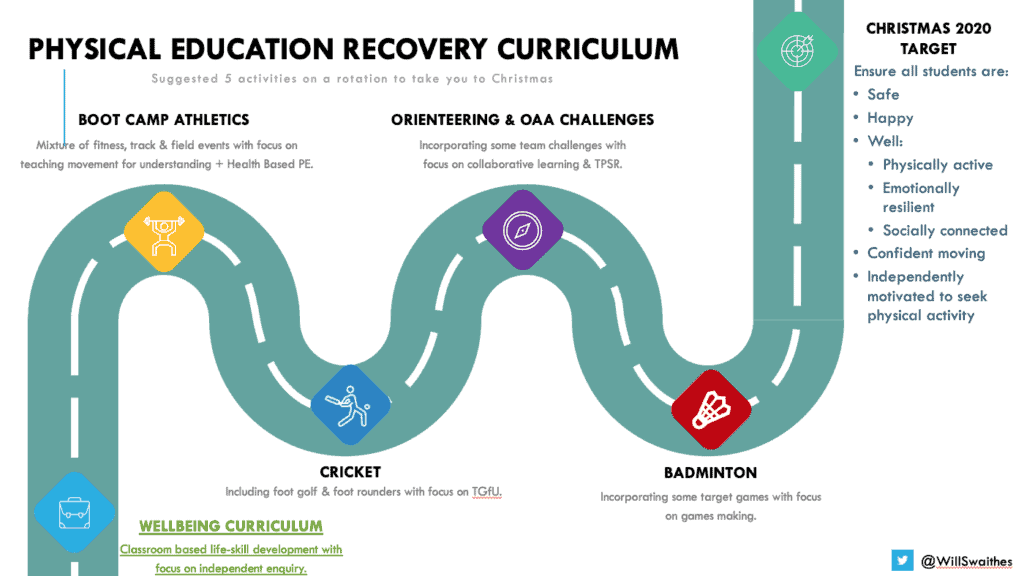
Consequently, I have developed a ‘Wellbeing Curriculum’ resource. This is a series of classroom-based wellbeing lessons to reduce the planning burden on teachers and offer something fresh, relevant, and exciting which also addresses aspects of the Relationship and Sex Education (RSE) curriculum. The materials could equally be used for remote teaching or assembly themes and many schools have incorporated it as their go to wet weather solution. In conjunction with this, I suggested a number of ‘Covid-considered’ activities (for example boot camp athletics, cricket, orienteering & OAA challenges and badminton) which could be taught, but with a more pedagogical focus on ‘how’ to teach them and what to focus on through them (for example Teaching Personal and Social Responsibility or Social and Emotional Learning).
Reflecting on research
Amid all this, I was able to complete my master’s dissertation to explore the relationship between happiness and daily physical activity (DPA). I completed a literature review and analysed data from 6,276 eleven to 16-year olds in 21 schools I work closely with in Nottinghamshire. The findings add to the mass of evidence demonstrating an axiomatic relationship. The cycle is vicarious: more DPA leads to increased happiness which in turn typically results in further increased DPA. Unsurprisingly to me, the least active adolescents represented the least happy. Perhaps the most interesting finding though, was that the ‘tipping point’ of median happiness for girls (seven out of ten on a Likert scale) required at least three days of 30 or more minutes physical activity (versus two for boys) and there was another significant shift at five days. Consequently, as research informs us that many older adolescent girls do not engage in PA beyond curriculum PE time, there is a strong argument for increasing physical education provision in schools as opposed to reducing it.
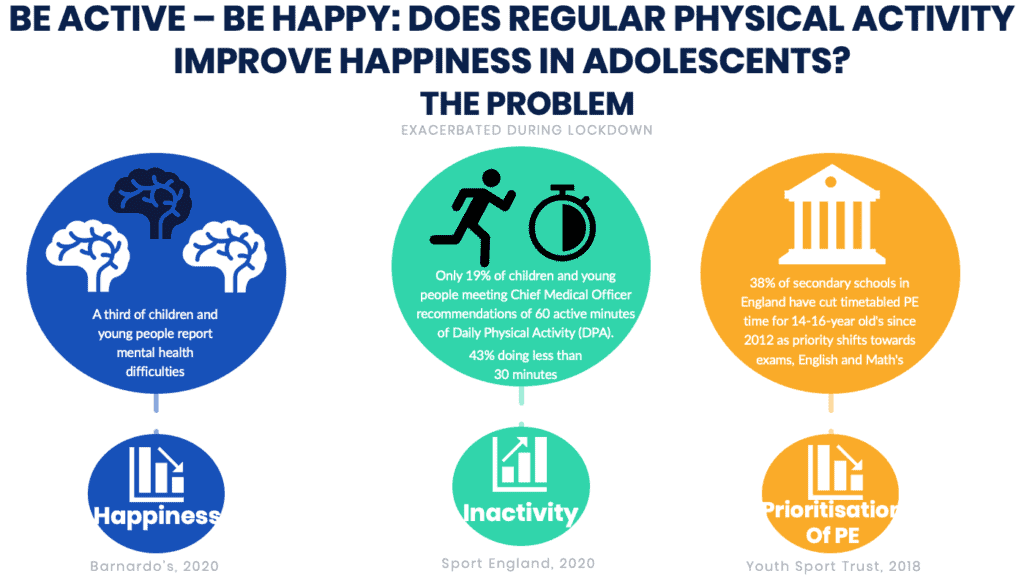
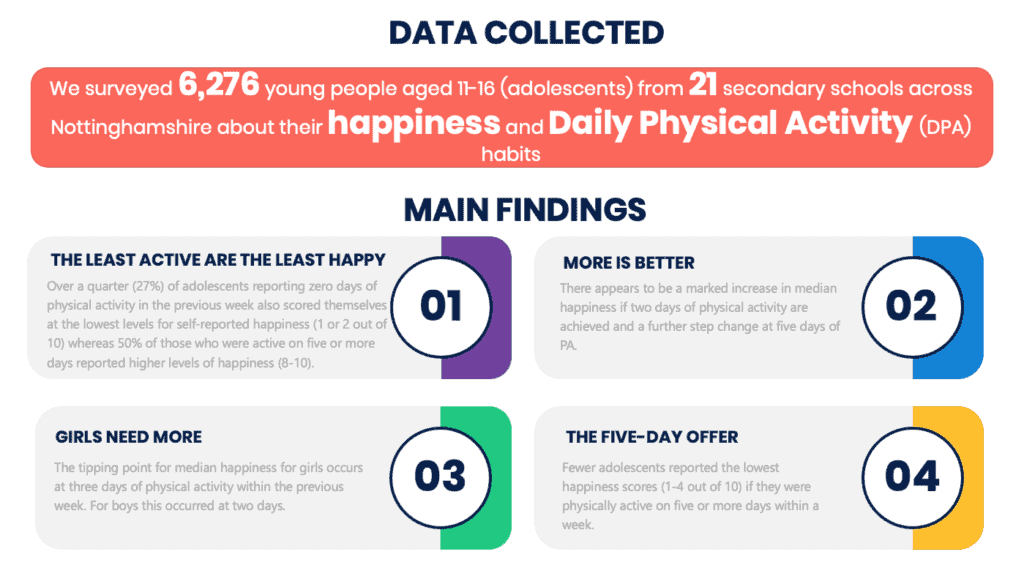
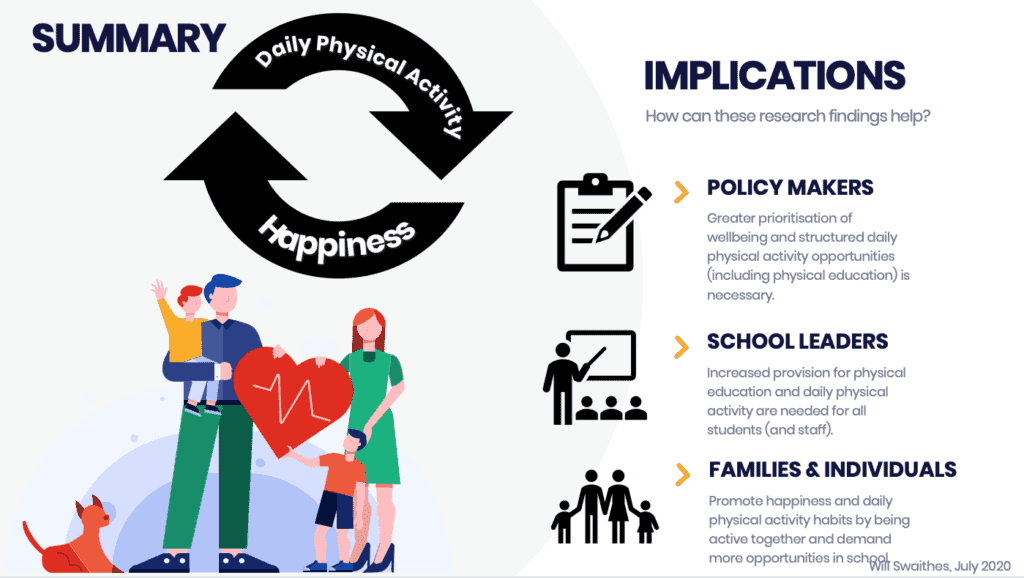
Sport England[17] and Youth Sport Trust[18] are reporting significant concerns around activity levels and wellbeing. So, if the country ever needed inspired and courageous physical educators, surely now is the time!
A brighter future for young people and the profession
Whilst the pandemic has reaped havoc, I remain confident that we will recover stronger and more focused as a result. Within physical education we have been given some time to think, an expectation to alter provision and a chance to consider who needs our help most in school. COVID-19 brought about a pressure to react quickly, to come together and support each other, to embrace the power of technology, and to really consider why our subject is needed. The data which I and others have gathered correlating higher levels of physical activity to higher feelings of wellbeing and happiness are incontrovertible[19].
Whilst those of us embedded in PE know that it can be so much more than copying a Personal Trainer’s workout over YouTube, it is exciting to be able to re-focus on what the profession can do to better cater for the individual needs, attitudes and motivations of today’s children. A focus on wellbeing, combined with the efforts and decisions of policy makers, school leaders and families, can lay the groundwork for students to benefit from a happy, healthy and successful future.
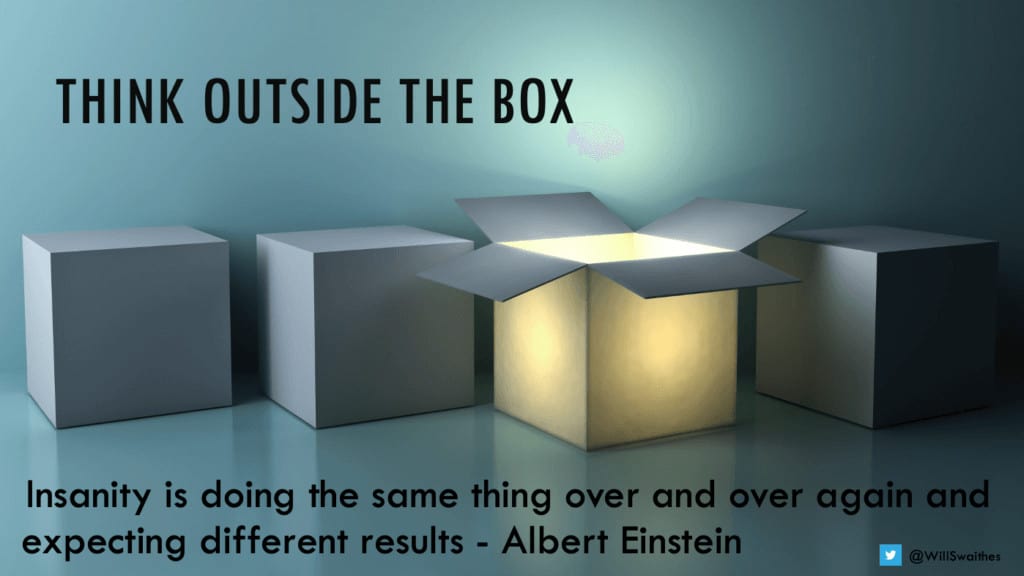
Want to find out more?
Here are some useful links:
- Access the Wellbeing Curriculum here
- Read the full research paper on exploring the relationship between physical activity and happiness here
- Listen to Global Perspectives of PE interviews with renowned teachers, teacher educators and researchers from around the world
References
- [1]
- [2] Twitter poll on proportion of students completing a PE or sport qualification on 12th May 2020
- [3] Under the skin – Sport England research
- [4] Twitter poll on curriculum design on 15th September 2020
- [5] Twitter poll on types of work being set for core PE on 4th May 2020 showed 51.4% indoor fitness
- [6] Twitter poll on 4th May showing 42.8% of respondents suggesting less than 25% CYP engaging with KS3 core PE remote learning
- [7] Twitter poll by The Teacher Toolkit on 2nd May 2020 showing 66.4% doing no live video teaching
- [8] DXBPE: A Safe Return To PE Webinar
- [9] Twitter polls on 23rd May showing 52% no PE and 9th June 2020 showing 76% doing no practical PE for Year 10 in June
- [10] Twitter poll on 13th June 2020 showing 41% worried about H&S + 36% worried about PE being omitted from the offer
- [11] Twitter summary on 25th September showing small changes to GCSE PE specification for summer 2021
- [12] Twitter polls on 8th July, 10th July and 6th September 2020 regarding changing room use and PE kit
- [13] Twitter polls on 30th June, 4th September, 9th September 2020 suggesting very little enrichment opportunity
- [14] Twitter poll by AfPE on 13th September 2020 showing 21% schools currently delivering less PE than usual
- [15] Twitter poll on 3rd June showing 60% ‘random activities’ plan for return to school in September
- [16] Wellbeing Curriculum orientation video and links to access
- [17] Sport England Activity Levels research showing 40% of CYP doing less than 30 minutes of PA during lockdown
- [18] Returning to school after COVID restrictions report showing 73% of teachers noticing lower levels of physical fitness amongst pupils
- [19] Sport England research – physical activity can help children catch up on missed work


[…] has already worked with us on the highly successful Wellbeing Curriculum and shared his story about PE’s response to covid-19. Will joins us with over 20 years’ experience in education with previous roles including Advanced […]
[…] Reframe’, ‘Teaching Wellbeing‘ and ‘Leading Change‘ webinars and my ‘covid-19 and PE – Reflections on the impact so far‘ and ‘New Year, New Start – ideas to support a move beyond covid-19‘ blogs have […]